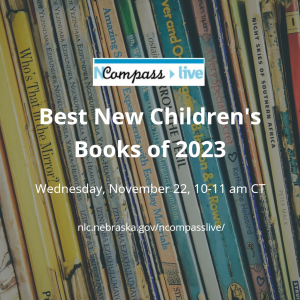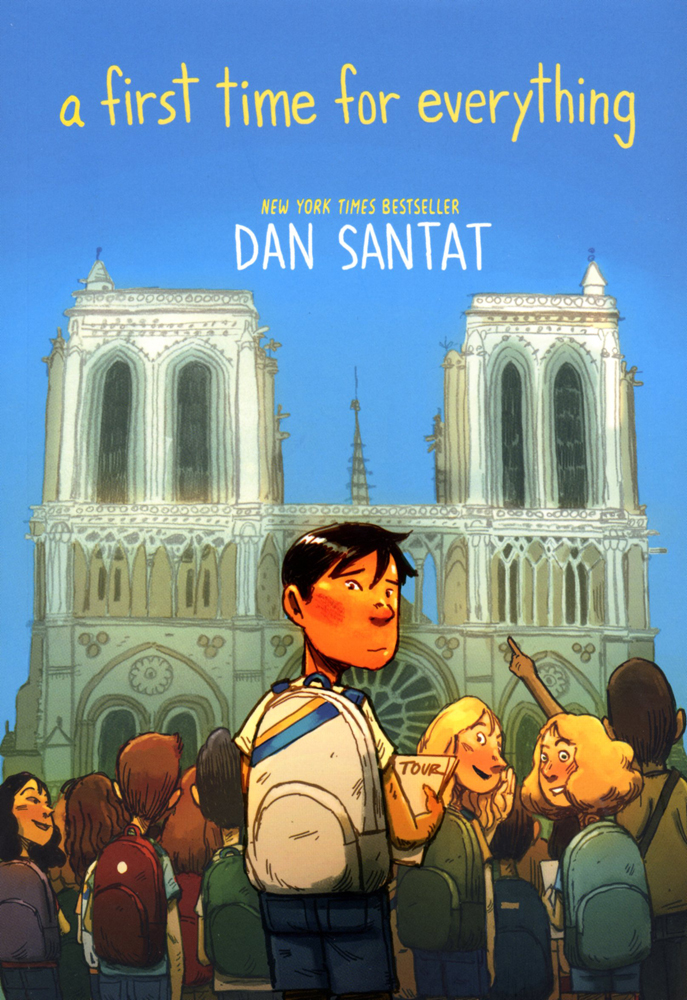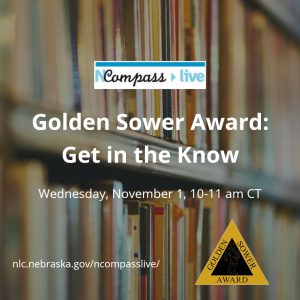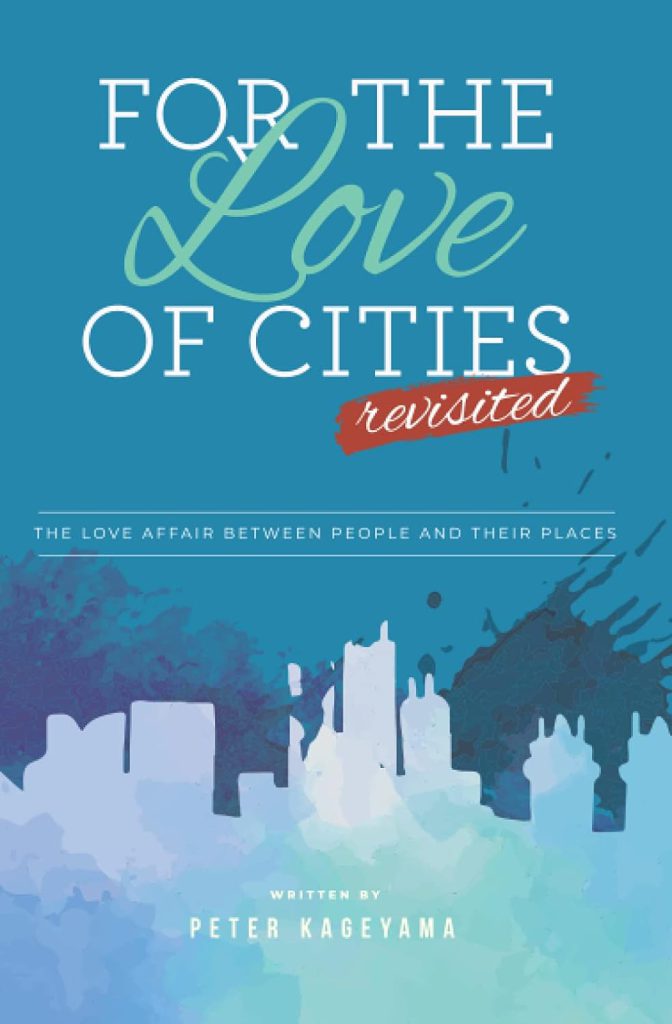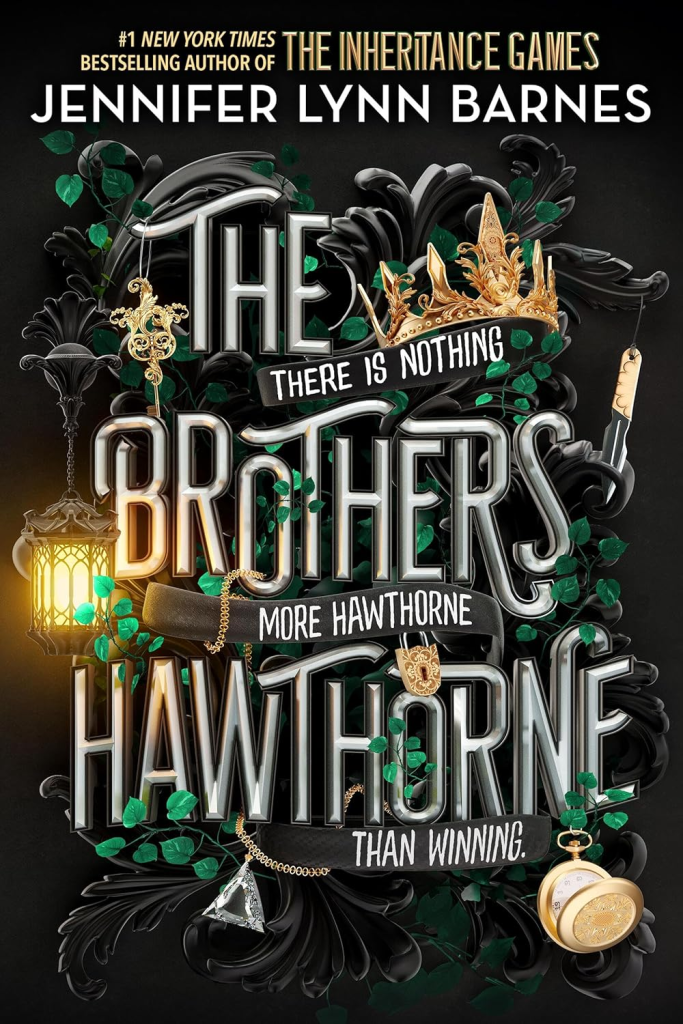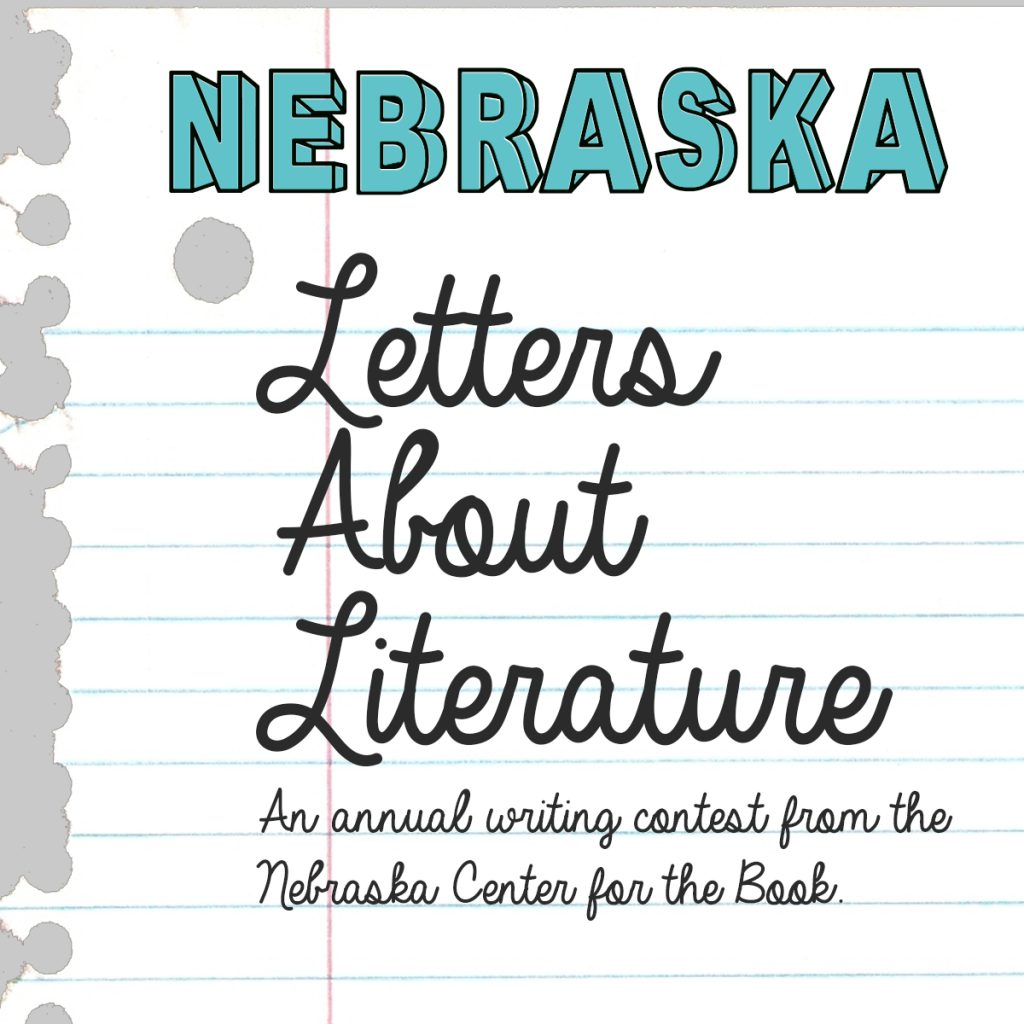Search the Blog
Categories
- Books & Reading
- Broadband Buzz
- Census
- Education & Training
- General
- Grants
- Information Resources
- Library Management
- Nebraska Center for the Book
- Nebraska Memories
- Now hiring @ your library
- Preservation
- Pretty Sweet Tech
- Programming
- Public Library Boards of Trustees
- Public Relations
- Talking Book & Braille Service (TBBS)
- Technology
- Uncategorized
- What's Up Doc / Govdocs
- Youth Services
Archives
Subscribe
Category Archives: Books & Reading
NCompass Live: Best New Children’s Books of 2023
Hear about the ‘Best New Children’s Books of 2023’ on next week’s NCompass Live webinar on Wednesday, November 22, at 10am CT.
Sally Snyder, the Nebraska Library Commission’s Coordinator of Children and Young Adult Library Services, will give brief book talks on titles published in the last year that could be good additions to your library’s collection. Titles for pre-school through elementary school will be included.
Upcoming NCompass Live shows:
- Nov. 29 – Pretty Sweet Tech: Internet Librarian 2023 Highlights
- Dec. 6 – Using Creativity to Grow & Develop
- Dec. 13 – Canvaholic
- Dec. 20 – Summer Reading Program 2024: Adventure Begins at Your Library
- Jan. 17, 2024 – Auditing Library Websites
- Jan. 24, 2024 – Best New Teen Reads of 2023

To register for an NCompass Live show, or to listen to recordings of past shows, go to the NCompass Live webpage.
NCompass Live is broadcast live every Wednesday from 10am – 11am Central Time. Convert to your time zone on the Official U.S. Time website.
The show is presented online using the GoTo Webinar online meeting service. Before you attend a session, please see the NLC Online Sessions webpage for detailed information about GoTo Webinar, including system requirements, firewall permissions, and equipment requirements for computer speakers and microphones.
#BookFaceFriday “Everything We Keep” by Kerry Lonsdale
Get swept away with #BookFaceFriday!
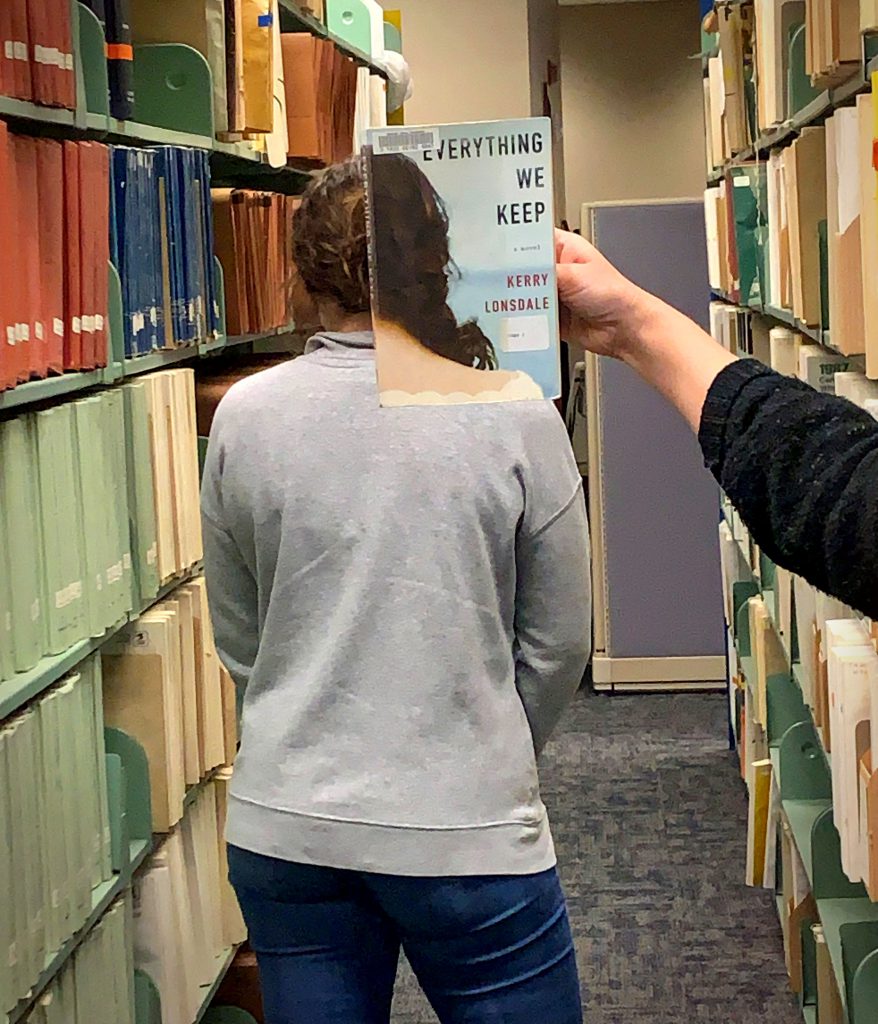
We love adding new titles to our collection, just like his week’s #BookFace, “Everything We Keep: A Novel” by Karen Abbott (Lake Union Publishing, 2016.) It’s such good book karma when book clubs or libraries donate to us after they’re done reading a book, and allows us to pass it on to all the other book clubs across the state. Thanks to Kearney Public Library, we have twelve copies of this title available as your next book club read – add it to your to-be-read list today!
“In Everything We Keep, Kerry Lonsdale brilliantly explores the grief of loss, if we can really let go of our great loves, and if some secrets are better left buried. With a good dose of drama, a heart-wrenching love story, and the suspense of unanswered questions, Lonsdale’s layered and engrossing debut is a captivating read.”
— Karma Brown, bestselling author of Come Away With Me
Book Club Kits Rules for Use
- These kits can be checked out by the librarians of Nebraska libraries and media centers.
- Circulation times are flexible and will be based upon availability. There is no standard check-out time for book club kits.
- Please search the collection to select items you wish to borrow and use the REQUEST THIS KIT icon to borrow items.
- Contact the Information Desk at the Library Commission if you have any questions: by phone: 800/307-2665, or by email: Information Services Team
Love this #BookFace & reading? Check out our past #BookFaceFriday photos on the Nebraska Library Commission’s Facebook page!
Posted in Books & Reading, General
Tagged Book Club Kits, bookfacefriday, Everything We Keep, Kerry Lonsdale, Novel, Reading
Leave a comment
Friday Reads: A First Time for Everything by Dan Santat
Announced yesterday, A First Time for Everything has won the National Book Foundation Award for Young People’s Literature.
It is on my Summer Reading Program list for 2024 and is a memoir of a three week school trip to Europe in 1989, the summer after 8th grade. In middle school Dan learned to be “…quiet. Small. … invisible.” (p. 11) Then one day, at the end of a school assembly Dan was unexpectedly asked (forced) to give his speech as practice for the speech tournament. It was a poem by A. A. Milne. He was ridiculed.
Then he took the three week school trip to Europe. Quiet at first, he slowly begins to have fun with some of the other students. And actually enjoying the trip. He does get lost in the middle of the night in France, but manages to steal a bike and find his way back (not proud of stealing the bike). Kirkus says, “Full of laughter and sentiment, this is a nudge for readers to dare to try new things.” (12/15/22)
Other Finalists for the Award for Young People’s Literature were:
Gather by Kenneth M. Cadow
Huda F Cares? by Huda Fahmy
Big by Vasti Harrison
The Lost Year: A Survival Story of the Ukrainian Famine by Katherine Marsh
Visit their web page to learn more. You can also see the winners and finalists in the other four categories on this web site.
Dan Santat is an author and illustrator of a variety of children and teen books, including After the Fall (How Humpty Dumpty Got Back Up Again), The Aquanaut, Sidekicks: A Graphic Novel, and Lift by Minh Lê and illustrated by Dan Santat.
Santat, Dan. A First Time for Everything. First Second/Macmillan, 2022.
#BookFaceFriday “Women in White Coats” by Olivia Campbell
Paging #BookFaceFriday, Stat!
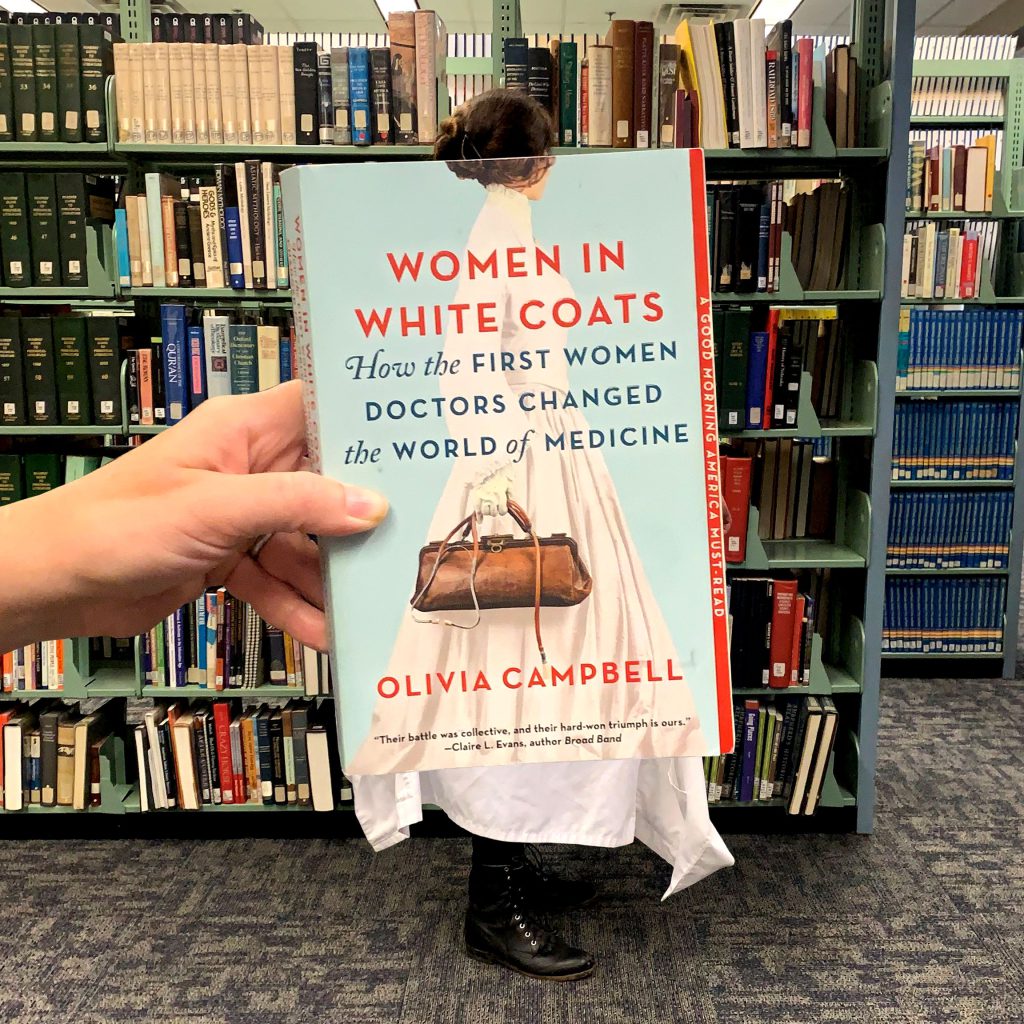
This nonfiction account of Victorian-era medicine and female doctors makes for an incredible #BookFaceFriday! You might have noticed this week’s title is new to the Book Club Kit collection, on the New York Times Bestseller list, or in our Browse New Additions section. Check out “Women in White Coats: How the First Women Doctors Changed the World of Medicine” by Olivia Campbell (Park Row, 2022.) We currently have eleven copies available in our Book Club Kit Collection. It’s also available as an ebook in Nebraska OverDrive Libraries.
“An engrossing portrait of a transformative moment in Victorian medicine, when women doctors demanded the right to heal and be healed. Their battle was collective, and their hard-won triumph is ours. Women in White Coats is a timely reminder of just how many hands it takes to move mountains.”
— Claire L. Evans, author of Broad Band: The Untold Story of the Women Who Made the Internet
Book Club Kits Rules for Use
- These kits can be checked out by the librarians of Nebraska libraries and media centers.
- Circulation times are flexible and will be based upon availability. There is no standard check-out time for book club kits.
- Please search the collection to select items you wish to borrow and use the REQUEST THIS KIT icon to borrow items.
- Contact the Information Desk at the Library Commission if you have any questions: by phone: 800/307-2665, or by email: Information Services Team
Find this title and many more through Nebraska OverDrive! Libraries participating in the Nebraska OverDrive Libraries Group currently have access to a shared and growing collection of digital downloadable audiobooks and eBooks. 189 libraries across the state share the Nebraska OverDrive collection of 21,696 audiobooks, 35,200 eBooks, and 3,964 magazines. As an added bonus it includes 130 podcasts that are always available with simultaneous use (SU), as well as SU ebooks and audiobook titles that publishers have made available for a limited time. If you’re a part of it, let your users know about this great title, and if you’re not a member yet, find more information about participating in Nebraska Overdrive Libraries!
Love this #BookFace & reading? Check out our past #BookFaceFriday photos on the Nebraska Library Commission’s Facebook page!
Friday Reads: Goldenrod by Maggie Smith
I am going to come out and say it: when our license plates were the meadowlark and the goldenrod, I loved them. I thought they were beautiful. Goldenrod may look like the allergy sufferer’s nemesis, ragweed, but is it innocent, blameless, unfairly maligned! A lovely, important part of our ecosystem, and a worthy state flower.
That was not why I chose to read Maggie Smith’s 2021 poetry collection, Goldenrod, but it was a point in her favor. One of my favorite poems is actually Smith’s “Good Bones.” My copy of Goldenrod was gifted to me from a friend and former mentor; it is possible that I have shared “Good Bones” to my social media so often that I have become associated with Maggie Smith (high praise).
Goldenrod is composed of three sections of poetry, the themes of which are: birth, death, nature, motherhood, and life. There’s a sprinkling of an homage to Mary Oliver — just a hint, just a flavor; to me, no one can hold a candle to Mary. But Mary was just one part of the conversation, and there must be other voices now.
A couple of poems that stood out after my reading were: “For My Next Trick” and “Wild.”
“For My Next Trick” centers around a conversation between the narrator — a mother — and her daughter, who asks
“Where was I …
before I was in your body?
–What was I?”
It’s a conversation about where we (might) come from, and what (might) happen after we die, and the connection between death and life, and what (might) go on after us. The (maybe) answer comes in the last stanzas of the poem-conversation:
I tell her the stars
are the exception–
burned out but still lit.
No, not ghosts,not exactly. Nothing
to be scared of.
That final sentence “Nothing to be scared of” is so poignant in its simplicity, the tone perfectly set for talking to a child — and as a result, it is comforting regardless of age.
“Wild” really called to mind the Mary Oliver homage for me; there is so much to loving the world, and struggling to love it, and just existing despite the brutality of man and nature. “Wild” also feels like a worthy companion to “Good Bones.”
I’ve talked so much about loving the world
without any idea how to do it.
…
The world I’m trying to love
is all teeth and need, all gray mange
All poetry is conversation, and I hear these lines as speaking towards “At the River Clarion“, specifically one of my favorite lines, which itself spins back to Tennyson, and nature, red in tooth and claw (In Memoriam A. H. H.):
If God exists he isn’t just butter and good luck.
He’s also the tick that killed my wonderful dog Luke.
Said the river: imagine everything you can imagine, then keep on going.
Overall, a delightful and meditative collection of poetry that can be read in an afternoon — but probably should be read slowly, and savored like a good cup of tea.
Maggie Smith is the author of several other poetry collections, as well as her 2023 memoir, You Could Make this Place Beautiful.
Smith, Maggie. Goldenrod: Poems. One Signal Publishers/Atria, 2021.
Book Club Spotlight – Tales of Burning Love
Today’s Book Club Spotlight is a title from prolific Ojibwe (Chippewa)/ German-American author Louise Erdrich! And I can’t think of a better author to start off Native American Heritage Month with. A Pulitzer Prize Winner, Erdrich was one of the first women admitted to Dartmouth College, later becoming the writer in residence for their Native American Studies Program. Today’s title, Tales of Burning Love, is the 5th in her series Love Medicine, following a community in and around a fictional Ojibwe reservation.
We are introduced to Jack Mauser on the day he met, married, and lost his first wife. Now, years later, his four other ex-wives gather together after tragedy and find themselves retracing the steps of their predecessor. Dot, the last wife; Candice, the young mother; Marlis, the dentist; and Eleanor, the only one who still loves him. All four women, unable to cut themselves entirely from Mauser, were taken in at one point or another by his earnest but selfish ways. Stuck in Jack’s car during a blizzard, they recall their relationships with the man as wild and passionate as the storm outside.
“Love is brutalizing, a raw force, frail as blossoms, tough as a catgut wire.”
Louise Erdrich
Tales of Burning Love is about more than just blind, passionate love. It follows the trauma of loss, ruinous devotion, and religious ecstasy. The stories the wives tell intermingle and blow with the raging storm outside. While Jack Mauser may be at the center of each story, his involvement, and true nature shape and lead the women far beyond his reach. Their hopes and aspirations start or end at his feet. For Adult Book Club Groups looking for stories to curl up with as the weather gets colder, Erdrich’s prose and darkly humorous storytelling are enough to keep you burning through any storm.
This is Erdrich’s second time featured in the Spotlight, the other being her children’s book The Birchbark House, following the day-to-day life of young Omakayas in 1847.
If you’re interested in requesting Tales of Burning Love for your book club, you can find the Request Form here. There are 5 copies available. (A librarian must request items)
Erdrich, Louise. Tales of Burning Love. HarperPerennial. 1996.
Posted in Books & Reading
Tagged book club spotlight, books, Native American Literature, Reading
Leave a comment
Friday Reads, the Wizard Hunters, Book 1 of the Fall of Ile Rien series, by Martha Wells
Years ago I read The Wizard Hunters, by Martha Wells, and waited expectantly for the rest of the series to come out, The Ships of Air, and The Gate of Gods. So after reading her more recent work (the Murderbot series), I wondered how the older series compared. It’s still wonderful world building, character building, and plotting,
We meet Tremaine Valiarde at her home estate, trying to find a suitable manner of suicide. Her city, country, and world, are under attack by an unknown enemy they call the Gardier. They don’t even know where on their world these people come from. The sinister black dirigibles started attacking with bombs and were protected with a magic they couldn’t protect themselves from. Tremaine has been working in the war effort, risking her life in the ruins to save lives, and is so very tired. She’s been put on leave by her relief group. In Tremaine’s world, Ile Rien is her country, somewhat French in flavor, and set approximately the early 1900s—along with magic and wizards; there are telephones, electric lights, radios, motor cars, and guns.

Tremaine is recruited, with a magical childhood toy, the Damal Sphere, to assist in classified work on an unknown spell left by the foremost wizard of her country, and her godfather, Damal, and Nicholas Valiard, her father, after they disappeared shortly before the war. The sphere had been copied for use with the spell, but backfired tragically. The hope is that the original will make it work correctly. It does, of course, and transports them to a different world. Where wizards are called Sorcerers and are all homicidally mad. The natives of the closest nation are Syprians, and each city is built near a magical source they call a God, which protects them from sorcerers, and their creations, curslings. It is on a small island off the Syprian coast often used by sorcerers, that the group from Ile Rien find themselves shipwrecked. A Chosen of the God, Giliad, and his foster brother Illias, are trying to check the same island for the return of a sorcerer, which is their job, to find and kill sorcerers. Instead of traditional sorcerers, they find a Gardier base. Since the technology is beyond their own level, the assume most of it is “curse” driven, (spelled), when it’s actually guns, electric lights, and an air ship. But the Gardier have magic, too. The pair have never seen or heard of these people before. Syprians are well-traveled merchants, trade with other countries and groups in their world.
Tremaine is an interesting character to begin with, her father is much like a blend of Sherlock Holmes and Moriarity. Two of her guardians are wizards, and one, unknown to her until the events of the book, is one of the Queen’s guard. While she herself feels a bit split about her personality—she was known as a playwright before the war, and the way she can react to threats, is commented on by her new friend, Florian, a wizard in training. She tries to keep the more menacing side of her personality hidden, as well as the strange set of talents learned from her father and his friends. However, in the situations in the series, she certainly grows to accept them, as they come in handy.
Illias and Gilead, from the Syprian mainland are also an interesting pair of men. Their civilization is a matriarchy, so property is passed through the female line, although wars are fought by both sexes. As a Chosen of the God, Gilead can sense “curses”, but has more difficulty sensing the spells of the Ile Rien wizards. They both have a tragic backstory, where a sorcerer fooled them both, and cursed to death three female members of their family.
The Fall of Ile Rien series is much like potato chips—it’s hard to stop at just one.
Posted in Books & Reading
Tagged Fantasy, Friday Reads, Martha Wells, The Wizard Hunters
Leave a comment
#BookFaceFriday “El Conejito Knuffle” by Mo Willems
¿Dónde está el #BookFaceFriday?
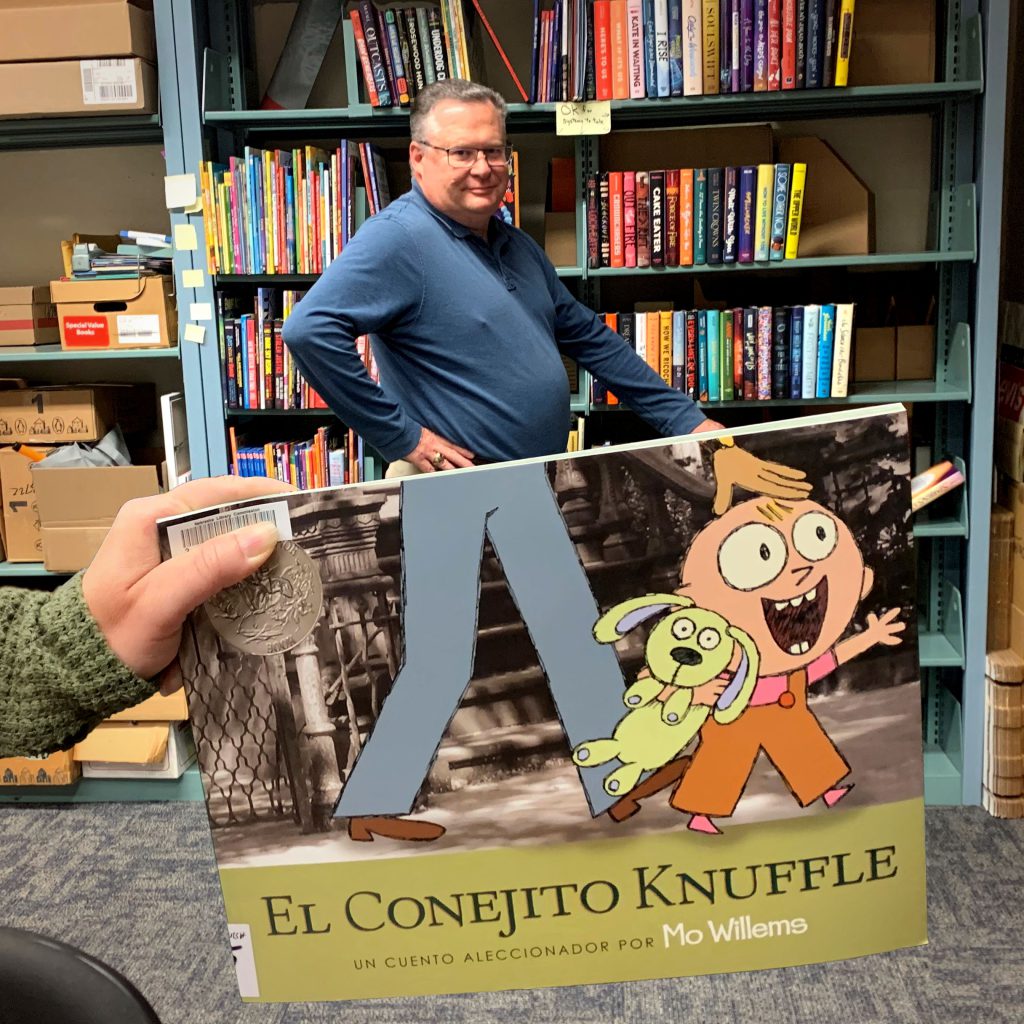
No need to retrace your steps to find this #BookFaceFriday! This week, we are highlighting one of the new Spanish language titles recently added to our Book Club Kit Collection, “El Conejita Knuffle” by Mo Willems (Hyperion Books for Children, 2007).
Browse all available titles using the keyword “Spanish” in the keyword search field. For kits that were already available in English, the title will be shown in English; for titles only available in Spanish, the Spanish title will be shown. For both types of kits, the number of Spanish copies is listed at the bottom of the title’s record. At the present time, most of our new Spanish-language kits are geared towards younger readers, but we hope to expand this selection in the future.“En esta combinación de unos expresivos dibujos de c
mic con preciosas fotografías de Brooklyn, Nueva York, el autor de ¡No dejes que la paloma condeuzca el autobús! crea un cuento brillante de la vida real sobre lo que pasa cuando Papá es el que manda, y todo sale humorística ya terriblemente mal.
Using a pastiche of muted black and white photography and expressive illustrations, this stunning book tells a brilliantly true-to-life tale about what happens when Daddy’s in charge and things go terribly, hilariously wrong..”
– Back cover
Book Club Kits Rules for Use
- These kits can be checked out by the librarians of Nebraska libraries and media centers.
- Circulation times are flexible and will be based upon availability. There is no standard check-out time for book club kits.
- Please search the collection to select items you wish to borrow and use the REQUEST THIS KIT icon to borrow items.
- Contact the Information Desk at the Library Commission if you have any questions: by phone: 800/307-2665, or by email: Information Services Team
Love this #BookFace & reading? Check out our past #BookFaceFriday photos on the Nebraska Library Commission’s Facebook page!
Posted in Books & Reading, General
Tagged Book Club Kits, bookface, bookfacefriday, El Conejita Knuffle, Knuffle Bunny, Mo Willems, Reading, Spanish
Leave a comment
Book Briefs: New University of Nebraska Press Books at the Nebraska Publications Clearinghouse
The Nebraska Publications Clearinghouse receives documents every month from all Nebraska state agencies, including the University of Nebraska Press (UNP). Each month we will be showcasing the UNP books that the Clearinghouse has received.
UNP books, as well as all Nebraska state documents, are available for checkout by libraries and librarians for their patrons.
Here are the UNP books the Clearinghouse received in September and October, 2023:
Almost Somewhere : Twenty-Eight Days on the John Muir Trail, by Suzanne Roberts. Series: Outdoor Lives.
Winner of the National Outdoor Book Award in Outdoor Literature
It was 1993, Suzanne Roberts had just finished college, and when her friend suggested they hike California’s John Muir Trail, the adventure sounded like the perfect distraction from a difficult home life and thoughts about the future. But she never imagined that the twenty-eight-day hike would change her life. Part memoir, part nature writing, part travelogue, Almost Somewhere is Roberts’s account of that hike.
John Muir wrote of the Sierra Nevada as a “vast range of light,” and that was exactly what Roberts was looking for. But traveling with two girlfriends, one experienced and unflappable and the other inexperienced and bulimic, she quickly discovered that she needed a new frame of reference. Her story of a month in the backcountry—confronting bears, snowy passes, broken equipment, injuries, and strange men—is as much about finding a woman’s way into outdoor experience as it is about the natural world Roberts so eloquently describes. Candid and funny, and finally, wise, Almost Somewhere not only tells the whimsical coming-of-age story of a young woman ill-prepared for a month in the mountains but also reflects a distinctly feminine view of nature.
This new edition includes an afterword by the author looking back on the ways both she and the John Muir Trail have changed over the past thirty years, as well as book club and classroom discussion questions and photographs from the trip.
The Complete Letters of Henry James, 1887-1888, Volume 2, Edited by Michael Anesko and Greg W. Zacharias, and Katie Sommer. Series: The Complete Letters of Henry James
This second volume of The Complete Letters of Henry James, 1887–1888 contains 182 letters, of which 120 are published for the first time, written from late December 1887 to November 19, 1888. These letters continue to mark Henry James’s ongoing efforts to care for his sister, develop his work, strengthen his professional status, build friendships, engage timely political and economic issues, and maximize his income. James details work on The Aspern Papers, The Reverberator, Partial Portraits, and The Tragic Muse. This volume opens with some of James’s social visits, includes the death of longtime friend Lizzie Boott, and concludes with James on the Continent.
Ecologies of Imperialism in Algeria, by Brock Cutler. Series: France Overseas: Studies in Empire and Decolonization.
Between 1865 and 1872 widespread death and disease unfolded amid the most severe ecological disaster in modern North African history: a plague of locusts destroyed crops during a disastrous drought that left many Algerians landless and starving. The famine induced migration that concentrated vulnerable people in unsanitary camps where typhus and cholera ran rampant. Before the rains returned and harvests normalized, some eight hundred thousand Algerians had died.
In Ecologies of Imperialism in Algeria Brock Cutler explores how repeated ecosocial divisions across an expansive ecosystem produced modern imperialism in nineteenth-century Algeria. Massive ecological crises—cultural as well as natural—cleaved communities from their homes, individuals from those communities, and society from its typical ecological relations. At the same time, the relentless, albeit slow-moving crises of ongoing settler colonialism and extractive imperial capitalism cleaved Algeria to France in a new way. Ecosocial divisions became apparent in performances of imperial power: officials along the Algerian-Tunisian border compulsively repeated narratives of “transgression” that over decades made the division real; a case of poisoned bread tied settlers in Algiers to Paris; Morocco-Algeria border violence exposed the exceptional nature of imperial sovereignty; a case of vagabondage in Oran evoked colonial gender binaries. In each case, factors in the broader ecosystem were implicated in performances of social division, separating political entities from each other, human from nature, rational from irrational, and women from men. Although these performances take place in the nineteenth-century Maghrib, the process they describe goes beyond those spatial and temporal limits—across the field of modern imperialism to the present day.
Encountering Palestine : Un/Making Spaces of Colonial Violence, Edited by Mark Griffiths and Mikko Joronen. Series: Cultural Geographies + Rewriting the Earth.
Encountering Palestine: Un/making Spaces of Colonial Violence, edited by Mark Griffiths and Mikko Joronen, sits at the intersection of cultural and political geographies and offers innovative reflections on power, colonialism, and anti-colonialism in contemporary Palestine and Israel. Organized around the theme of encountering and focusing on the ways violence and struggle are un/made in the encounter between the colonizer and colonized, the essays focus on power relations as they manifest in cultural practices and everyday lives in anti/colonial Palestine.
Covering numerous sites in Gaza, the West Bank, East Jerusalem, and Israel, Encountering Palestine addresses a range of empirical topics—from marriage and queer aesthetics to policing, demolition, armament failure, and violence. The contributors utilize diverse theoretical frameworks, such as hyperreality, settler capitalism, intimate biopolitics, and politics of vulnerability, to help us better understand the cultural making and unmaking of colonial and anti-colonial space in Palestine. Encountering Palestine asks us to rethink how colonialism and power operate in Palestine, the ways Palestinians struggle, and the lifeways that constantly encounter, un/make, and counter the spaces of colonial violence.
Galloping Gourmet : Eating and Drinking With Buffalo Bill, by Steve Friesen.
Galloping Gourmet explores an unfamiliar side of a familiar character in American history, William F. “Buffalo Bill” Cody. In this entertaining narrative Steve Friesen explores the evolving role of eating and drinking in Buffalo Bill’s life (1846–1917). Friesen starts with Buffalo Bill’s culinary roots on the American Plains, eating simple foods such as cornbread, fried “yellow-legged” chicken, and hardtack. Buffalo Bill discovered gourmet dining while leading buffalo-hunting expeditions and scouting. As his fame increased, so did his desire and opportunities for fine dining: his early show business career allowed him to dine at some of the best restaurants in the country.
Friesen examines the creation of Buffalo Bill’s Wild West Show in 1883, in which Cody introduced his diverse cast of employees to dining that equaled America’s best restaurants. One newspaper reporter observed that “Colonel Cody displays no more care about anything than the proper feeding of horse and man.” Cody opened the first Mexican restaurant east of the Mississippi and introduced American foodways to Europe. Equally comfortable eating around a campfire on the plains or at Delmonico’s in New York City, he also dined with leading celebrities of his day. In the final section Friesen addresses the controversies surrounding Cody’s drinking, his death, and his ongoing culinary legacy. Galloping Gourmet includes an appendix of more than thirty annotated period recipes.
Godfall : a Novel, by Van Jensen. Series: Flyover Fiction.
When a massive asteroid hurtles toward Earth, humanity braces for annihilation—but the end doesn’t come. In fact, it isn’t an asteroid but a three-mile-tall alien that drops down, seemingly dead, outside Little Springs, Nebraska. Dubbed “the giant,” its arrival transforms the red-state farm town into a top-secret government research site and major metropolitan area, flooded with soldiers, scientists, bureaucrats, spies, criminals, conspiracy theorists—and a murderer.
As the sheriff of Little Springs, David Blunt thought he’d be keeping the peace among the same people he’d known all his life, not breaking up chanting crowds of conspiracy theorists in tiger masks or struggling to control a town hall meeting about the construction of a mosque. As a series of brutal, bizarre murders strikes close to home, Blunt throws himself into the hunt for a killer who seems connected to the Giant. With bodies piling up and tensions in Little Springs mounting, he realizes that in order to find the answers he needs, he must first reconcile his old worldview with the town he now lives in—before it’s too late.
The Grapes of Conquest : Race, Labor, and the Industrialization of California Wine, 1769-1920, by Julia Ornelas-Higdon. Series: At Table.
California’s wine country conjures images of pastoral vineyards and cellars lined with oak barrels. As a mainstay of the state’s economy, California wines occupy the popular imagination like never before and drive tourism in famous viticultural regions across the state. Scholars know remarkably little, however, about the history of the wine industry and the diverse groups who built it. In fact, contemporary stereotypes belie how the state’s commercial wine industry was born amid social turmoil and racialized violence in eighteenth- and nineteenth-century California.
In The Grapes of Conquest Julia Ornelas-Higdon addresses these gaps in the historical narrative and popular imagination. Beginning with the industry’s inception at the California missions, Ornelas-Higdon examines the evolution of wine growing across three distinct political regimes—Spanish, Mexican, and American—through the industry’s demise after Prohibition. This interethnic study of race and labor in California examines how California Natives, Mexican Californios, Chinese immigrants, and Euro-Americans came together to build the industry. Ornelas-Higdon identifies the birth of the wine industry as a significant missing piece of California history—one that reshapes scholars’ understandings of how conquest played out, how race and citizenship were constructed, and how agribusiness emerged across the region. The Grapes of Conquest unearths the working-class, multiracial roots of the California wine industry, challenging its contemporary identity as the purview of elite populations.
The Incarceration of Native American Women : Creating Pathways to Wellness and Recovery Through Gentle Action Theory, by Carma Corcoran. Series: New Visions in Native American and Indigenous Studies.
In The Incarceration of Native American Women, Carma Corcoran examines the rising number of Native American women being incarcerated in Indian Country. With years of experience as a case management officer, law professor, consultant to tribal defenders’ offices, and workshop leader in prisons, she believes this upward trajectory of incarceration continues largely unacknowledged and untended. She explores how a combination of F. David Peat’s gentle action theory and the Native traditional ways of knowing and being could heal Native American women who are or have been incarcerated.
Colonization and the historical trauma of Native American incarceration runs through history, spanning multiple generations and including colonial wartime imprisonment, captivity, Indian removal, and boarding schools. The ongoing ills of childhood abuse, domestic violence, sexual assault, and drug and alcohol addiction and the rising number of suicides are indicators that Native people need healing. Based on her research and work with Native women in prisons, Corcoran provides a theory of wellness and recovery that creates a pathway for meaningful change. The Incarceration of Native American Women offers students, academics, social workers, counselors, and those in the criminal justice system a new method of approach and application while providing a deeper understanding of the cultural and historical experiences of Native Americans in relation to criminology.
Nebraska Volleyball : the Origin Story, by John Mabry.
When Title IX was enacted in 1972, the University of Nebraska volleyball program, like many across the country, received a fraction of the funding and attention given to the school’s mighty football program. The players had to organize a run from Lincoln to Omaha to raise money for uniforms. The women were asked to wait their turn to use the weight room. Today the Nebraska women’s volleyball team is one of the sport’s most decorated programs—with more career wins than any other program and five NCAA National Championships—and draws standing-room-only crowds at home games in the 8,000-seat Devaney Center.
Nebraska Volleyball is the first book to recount how volleyball took hold at Nebraska, through Pat Sullivan, the team’s first coach; through such early figures as Cathy Noth, a decorated player and later an assistant coach into the 1990s; through Terry Pettit, who coached the team for twenty-three seasons and led it to its first National Championship in 1995; and through John Cook, who took over as head coach in 2000. John Mabry highlights the small Nebraska towns that have sent some of the best players to the program and helped build statewide support for the team. Public television helped too, with its power to broadcast games early on and thus build a following across the state.
The success of Nebraska’s volleyball program is one of the greatest stories in sports. As Karch Kiraly, head coach for the U.S. National Women’s Volleyball Team, said: “If you want to learn about women’s college volleyball, your first stop has to be Lincoln, Nebraska.”
Of Love and War : Pacific Brides of World War II, by Angela Wanhalla. Series: Studies in Pacific Worlds.
Between 1942 and 1945 more than two million servicemen occupied the southern Pacific theater, the majority of whom were Americans in service with the U.S. Army, Navy, Air Force, and Marines. During the occupation, American servicemen married approximately 1,800 women from New Zealand and the island Pacific, creating legal bonds through marriage and through children. Additionally, American servicemen fathered an estimated four thousand nonmarital children with Indigenous women in the South Pacific Command Area.
In Of Love and War Angela Wanhalla details the intimate relationships forged during wartime between women and U.S. servicemen stationed in the South Pacific, traces the fate of wartime marriages, and addresses consequences for the women and children left behind. Paying particular attention to the experiences of women in New Zealand and in the island Pacific—including Tonga, Fiji, Samoa, and the Cook Islands—Of Love and War aims to illuminate the impact of global war on these women, their families, and Pacific societies. Wanhalla argues that Pacific war brides are an important though largely neglected cohort whose experiences of U.S. military occupation expand our understanding of global war. By examining the effects of American law on the marital opportunities of couples, their ability to reunite in the immediate postwar years, and the citizenship status of any children born of wartime relationships, Wanhalla makes a significant contribution to a flourishing scholarship concerned with the intersections between race, gender, sexuality, and militarization in the World War II era.
Rise Up! : Indigenous Music in North America, by Craig Harris.
Music historian Craig Harris explores more than five hundred years of Indigenous history, religion, and cultural evolution in Rise Up! Indigenous Music in North America. More than powwow drums and wooden flutes, Indigenous music intersects with rock, blues, jazz, folk music, reggae, hip-hop, classical music, and more. Combining deep research with personal stories by nearly four dozen award-winning Indigenous musicians, Harris offers an eye-opening look at the growth of Indigenous music.
Among a host of North America’s most vital Indigenous musicians, the biographical narratives include new and well-established figures such as Mildred Bailey, Louis W. Ballard, Cody Blackbird, Donna Coane (Spirit of Thunderheart), Theresa “Bear” Fox, Robbie Robertson, Buffy Sainte-Marie, Joanne Shenandoah, DJ Shub (Dan General), Maria Tallchief, John Trudell, and Fawn Wood.
Settler Aesthetics : Visualizing the Spectacle of Originary Moments in The New World, by Mishuana Goeman. Series: Indigenous Films.
In Settler Aesthetics, an analysis of renowned director Terrence Malick’s 2005 film, The New World, Mishuana Goeman examines the continuity of imperialist exceptionalism and settler-colonial aesthetics. The story of Pocahontas has thrived for centuries as a cover for settler-colonial erasure, destruction, and violence against Native peoples, and Native women in particular. Since the romanticized story of the encounter and relationship between Pocahontas and Captain John Smith was first published, it has imprinted a whitewashed historical memory into the minds of Americans.
As one of the most enduring tropes of imperialist nostalgia in world history, Renaissance European invasions of Indigenous lands by settlers trades in a falsified “civilizational discourse” that has been a focus in literature for centuries and in films since their inception. Ironically, Malick himself was a symbol of the New Hollywood in his early career, but with The New World he created a film that serves as a buttress for racial capitalism in the Americas. Focusing on settler structures, the setup of regimes of power, sexual violence and the gendering of colonialism, and the sustainability of colonialism and empires, Goeman masterfully peels away the visual layers of settler logics in The New World, creating a language in Native American and Indigenous studies for interpreting visual media.
The Sonoran Dynasty in Mexico : Revolution, Reform, and Repression, by Jürgen Buchenau. Series: Confluencias.
Two generals from the northwestern state of Sonora, Álvaro Obregón and Plutarco Elías Calles, dominated Mexico between 1920 and 1934, having risen to prominence in the course of the Mexican Revolution. Torn between popular demands for ending the privileges of wealthy foreign investors and opposition by a hawkish U.S. administration and enemies at home, the two generals and their allies from their home state mixed radical rhetoric with the accommodation of entrenched interests.
In The Sonoran Dynasty in Mexico Jürgen Buchenau tells the story of this ruling group, which rejected the Indigenous and Catholic past during the decades of the revolution and aimed to reinvent Mexico along the lines of the modern and secular societies in western Europe and the United States. In addition to Obregón and Calles, the Sonoran Dynasty included Adolfo de la Huerta and Abelardo L. Rodríguez, four Sonorans among six presidents in less than two decades. Although the group began with the common aims of nationalism, modernization, central political control, and enrichment, Buchenau argues that this group progressively fell apart in a series of bloody conflicts that reflected broader economic, political, and social disagreements. By analyzing the dynasty from its origins through its eventual downfall, Buchenau presents an innovative look at the negotiation of power and state formation in revolutionary Mexico.
Ted Kooser : More Than a Local Wonder, by Carla Ketner, illustrated by Paula Wallace.
Long before Ted Kooser won a Pulitzer Prize for Poetry, served as the U.S. Poet Laureate, and wrote award-winning books for children, he was an unathletic child growing up in Iowa, yearning to fit in. Young Teddy found solace in stories, and one specific book, Robert McCloskey’s Lentil, inspired him to become a writer. As a child and later, while working in the insurance industry, Ted honed his craft and unique style as he wrote about the people and places of the rural Midwest. Ted Kooser: More Than a Local Wonder celebrates the power of stories and of finding oneself through words.
Washington State Politics and Government, by T.M. Sell. Series: Politics and Governments of the American States.
In the twenty-first century, as many candidates actively campaign against the very government they seek to serve in, and as many people appear to believe their government irreparably broken, T. M. Sell argues that in Washington State, the system works better than most realize. In Washington State Politics and Government Sell explains how the many parts of government function and introduces readers to a diverse array of individuals who work in government, including how they got there and what it is they’re trying to do. Sell covers the three branches of state government, plus county, city, special purpose district, and tribal governments. He explains the state budgets and taxes; the functions of major and better-known state agencies; how policy is made; the political landscape of Washington; and parties, voting, and elections.
Sell discusses economic development, including the importance of high-tech industry, aviation, Amazon.com, and more traditional parts of the state economy, such as timber and agriculture. He also provides a contemporary look at Washington’s elected officials, constitution, judiciary, media, demographics, and political culture and landscape. With this volume, any Washington citizen, student of politics, or specialist in government can gain insight into the state’s current political system.
**Pictures and Synopses courtesy of University of Nebraska Press.
NCompass Live: Golden Sower Award: Get in the Know
Learn all about Nebraska’s Children’s Choice Award, the Golden Sower, on next week’s NCompass Live webinar on Wednesday, November 1, at 10am CT.
The Nebraska Golden Sower Award is Nebraska’s Children’s Choice Literary Award, sponsored by the Nebraska Library Association. Since 1982, the Golden Sower Award has sought to sow seeds which stimulate children’s thinking, introduce different types of literature, encourage independent reading, increase library skills, and foster an appreciation for excellence in writing and illustrating. This presentation will address the nature of the award, describe the award process, provide updates on changes to the award and committee structure, and share how to get involved.
Presenter: Anne Price, Nebraska Golden Sower Award Committee Member; Children’s Librarian, North Platte Public Library.
Upcoming NCompass Live shows:
- Nov. 8 – Racial & Gender Bias in Search
- Nov. 15 – Redesigning a Library Website
- Nov. 22 – Best New Children’s Books of 2023
- Nov. 29 – Pretty Sweet Tech: Internet Librarian 2023 Highlights
- Dec. 6 – Using Creativity to Grow & Develop
- Dec. 13 – Canvaholic
- Dec. 20 – Summer Reading Program 2024: Adventure Begins at Your Library
- Jan. 17, 2024 – Auditing Library Websites
- Jan. 24, 2024 – Best New Teen Reads of 2023

To register for an NCompass Live show, or to listen to recordings of past shows, go to the NCompass Live webpage.
NCompass Live is broadcast live every Wednesday from 10am – 11am Central Time. Convert to your time zone on the Official U.S. Time website.
The show is presented online using the GoTo Webinar online meeting service. Before you attend a session, please see the NLC Online Sessions webpage for detailed information about GoTo Webinar, including system requirements, firewall permissions, and equipment requirements for computer speakers and microphones.
Friday Reads: For the Love of Cities, revisited by Peter Kageyama
A lot of you know that I’m not from Nebraska. I was born near Milwaukee, WI and lived there until I went to college in Minnesota. Over the years I’ve visited a lot of places too. Everywhere I go, I talk to people and get a feel for the place. I was in Tokyo, Japan most recently, so I’ll use that as an example. As I walked the streets of this foreign land, I had to remember that most people in the city were just home. Bear in mind that I don’t speak Japanese very well, but you can still tell who’s happy where they are, and who is crawling out of their skin waiting for a chance to leave.
That’s what For the Love of Cities: revisited by Peter Kageyama is all about. What does it take to make people fall in love with their city? Why do people choose some cities over others? Whenever I visit a new place, I can instinctively tell whether or not I could live there. I never really considered any actual criteria for the decision until I read this book. I just knew. Now I see greenery, coffee shops, places to relax and connect with people, clean streets, and plenty of shops and art embedded into the fiber of the community. I learned how to really look at a city.
My academic days still make me refer to authors by their last name. But this book makes people feel like family. So I’ll call him Peter. I don’t think he’ll mind, and I’ll also never meet him to find out. Peter digs into how cities come to be, and the many variables that force change over time. I also watched the author talk Peter did with Heritage Village. It’s free on YouTube if you want to check it out. That video adds visuals to his stories about how history shaped cities like Chicago, Detroit and many others. Sometimes dark parts of history like racial segregation and hate shape city lines that must be repaired over time for the city to adapt and thrive in the future.
When I visit other cities I usually dress to blend in. Just another Midwesterner in a t-shirt and leggings. In Japan I didn’t even try. Pretty sure I was the only curly-headed Native American in the whole country, so I wore bright colors or coffee t-shirts and capris everyday. My body type was never going to fit into such a petite country anyway. Even though their waffles are surprisingly good. I digress. Japan was awesome.
If you didn’t factor in the language barrier and distance from everything and everyone I know, I would actually live there. I walked the streets in my deeply American sandals and pondered how cities draw people in to live and work in a new land. What drew me to Lincoln, NE? What made me stay? The people? The place? The job? A little bit of all the above? I have new answers now.
Read this book if you want to look at your city differently. It’s a book full of stories and observations about little things that blend into the background of the place you’ve lived for years. When you’re done, take a walk around your city. Town. Wherever you call home. Try it with any town. Ask yourself why people choose this place? Why do people stay? If people are leaving, what could change to turn the tides? Peter will help you explore old places with fresh eyes. Just give it a try.
#BookFaceFriday – “Nothing But Blackened Teeth” by Cassandra Khaw
I wouldn’t want to run into this #BookFace in a dark hallway!
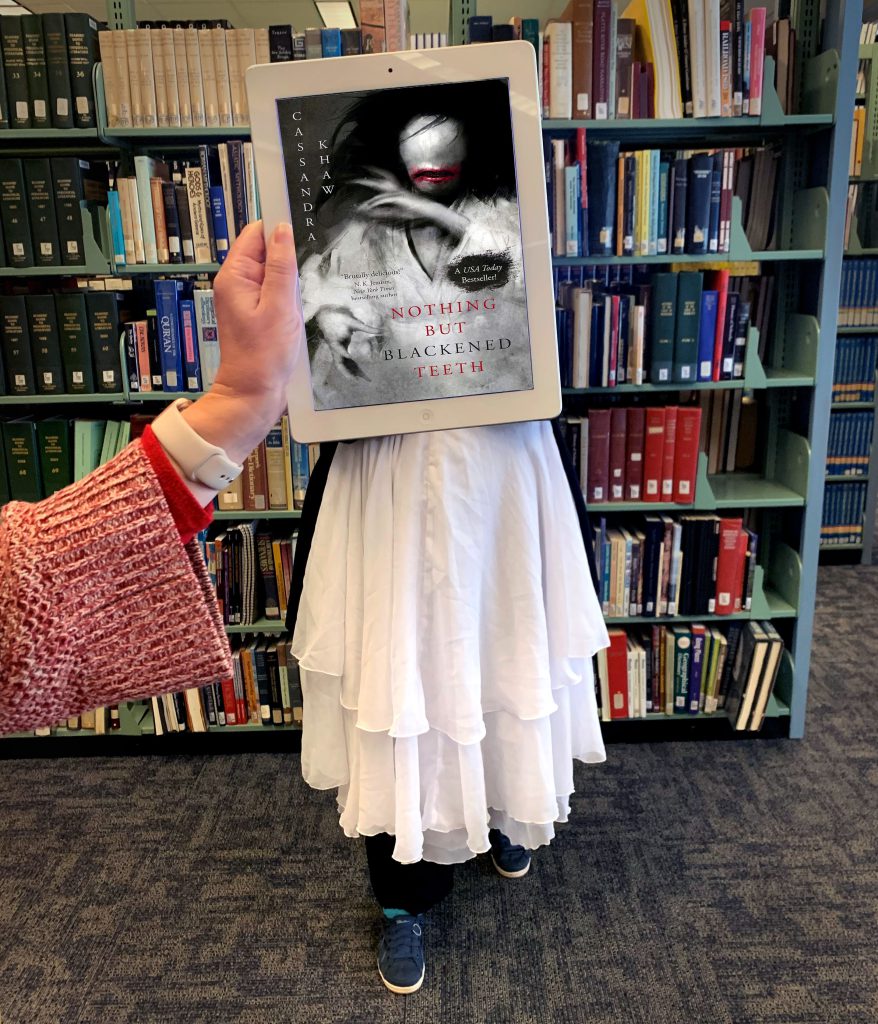
Not to make you lose sleep or anything but this week’s #BookFaceFriday has us keeping the lights on. If you love Halloween and a a good scary read, this USA Today bestseller is perfect for you; check out “Nothing But Blackened Teeth” by Cassandra Khaw (Berkley, 2014.) This title is available as an audiobook in Nebraska OverDrive Libraries. Find this title and other tales of horror in Nebraska OverDrive’s curated collection, “Hallow-Reads: Spooky tales for October nights“! Now if you’re looking for something fun and just a little spooky for the whole family, we also have the curated collection Spooky BOO-ks on our OverDrive Kid’s & Teens pages.
“If Guillermo del Toro directed The Ring, it might play out something like this engaging thriller. Japanese mythological creatures come to life in this dynamic, unique tale that will satisfy horror readers eager for fresh blood.”
—Booklist
Libraries participating in the Nebraska OverDrive Libraries Group currently have access to a shared and growing collection of digital downloadable audiobooks and eBooks. 189 libraries across the state share the Nebraska OverDrive collection of 21,696 audiobooks, 35,200 eBooks, and 3,964 magazines. As an added bonus it includes 130 podcasts that are always available with simultaneous use (SU), as well as SU ebooks and audiobook titles that publishers have made available for a limited time. If you’re a part of it, let your users know about this great title, and if you’re not a member yet, find more information about participating in Nebraska Overdrive Libraries!
Love this #BookFace & reading? Check out our past #BookFaceFriday photos on the Nebraska Library Commission’s Facebook page!
Book Club Spotlight – Dead as a Door Knocker
With Halloween a week away, I love to enjoy the spookier books in our collection. But what’s great about Halloween is that there are so many ways for readers to enjoy the season without getting too scared. So, for the scaredy cats this Halloween Season, we’ll be looking at Dead as a Door Knocker by author Diane Kelly. Kelly is a prolific, cozy mystery writer, having (accidentally) worked with white-collar criminals in her former work as a tax advisor and decided to author the criminals herself rather than working with them. She has been awarded the Golden Heart Award from the Romance Writers of America and a Reviewers’ Choice Award.
In the first installment in the House-Flipper Mystery series, we meet 20-something Whitney Whitaker, a property manager living in her parents’ (renovated) pool house with big dreams and a small cat named Sawdust. When a property goes up for sale by the cheapskate Rick Dunaway, Whitney snatches up the deal, thinking it was too good to be true. But she gets more than she bargained for when Rick’s body shows up in her flower bed a few days later! With the help of her best friend Collette, cousin Buck, and Nashville’s newest homicide detective, Collin Flynn, Whitney sets out to catch the killer with her life and the house’s market value on the line.
“Are you going to buy the murder house?”
Diane Kelly
With brief mentions of blood, peril, and, of course, a body, Dead as a Door Knocker is driven by its characters and their relationships, not a murderous fiend. As we tick through the list of potential suspects, there are plenty of stops along the way into the world of house-flipping, rentals, and kitty shenanigans. Cozy mysteries like Dead as a Door Knocker let the more squeamish in your book club groups enjoy the fun of solving a good mystery without all the blood and gore getting in the way.
If you’re interested in requesting Dead as a Door Knocker for your book club, you can find the Request Form here. There are 10 copies available. (A librarian must request items)
Kelly, Diane. Dead as a Door Knocker. St. Martin’s Press. 2019
NCompass Live: Pretty Sweet Tech: How Augmented Reality Can Create Optimal Literacy Experiences
Explore how Living Popups transforms classic and original books into interactive experiences on next week’s Pretty Sweet Tech NCompass Live webinar, ‘How Augmented Reality Can Create Optimal Literacy Experiences’, on Wednesday, October 25, at 10am CT.
Special monthly episodes of NCompass Live! Join the NLC’s Technology Innovation Librarian, Amanda Sweet, as she guides us through the world of library-related Pretty Sweet Tech.
LP Bookspace engages all readers and keeps them coming back for more! LP Bookspace brings to your library augmented reality experiences where characters literally jump off the page and help build comprehension and confidence.
The goal of this session is to explore how easy it is to create an optimal literacy experience within your library environment by applying innovative technology. You will discover the LB Bookspace tools to help you create an exciting Story Time, track students’ progress in the Dashboard, implement Book Clubs for older children and have families returning to your library again and again. You will learn about the Meet the Makers series introducing patrons of all ages to how the books are produced and the potential careers in the future all around great literature.
Join us to see how LP Bookspace could provide you with creative ways to deliver innovative programming to your community.
Guest Presenter: Cheryl Bayer, CEO, Living Popups, LLC.
Upcoming NCompass Live shows:
- Nov. 1 – Golden Sower Award: Get in the Know
- Nov. 8 – Racial & Gender Bias in Search
- Nov. 15 – Redesigning a Library Website
- Nov. 22 – Best New Children’s Books of 2023
- Dec. 6 – Using Creativity to Grow & Develop
- Dec. 13 – Canvaholic
- Dec. 20 – Summer Reading Program 2024: Adventure Begins at Your Library
- Jan. 17, 2024 – Auditing Library Websites
- Jan. 24, 2024 – Best New Teen Reads of 2023

To register for an NCompass Live show, or to listen to recordings of past shows, go to the NCompass Live webpage.
NCompass Live is broadcast live every Wednesday from 10am – 11am Central Time. Convert to your time zone on the Official U.S. Time website.
The show is presented online using the GoTo Webinar online meeting service. Before you attend a session, please see the NLC Online Sessions webpage for detailed information about GoTo Webinar, including system requirements, firewall permissions, and equipment requirements for computer speakers and microphones.
Posted in Books & Reading, Education & Training, Technology, Youth Services
Tagged NCompLive, prettysweettech
Leave a comment
#BookFaceFriday – “The Lesser Dead” by Christopher Buehlman
Something #BookFace this way comes!
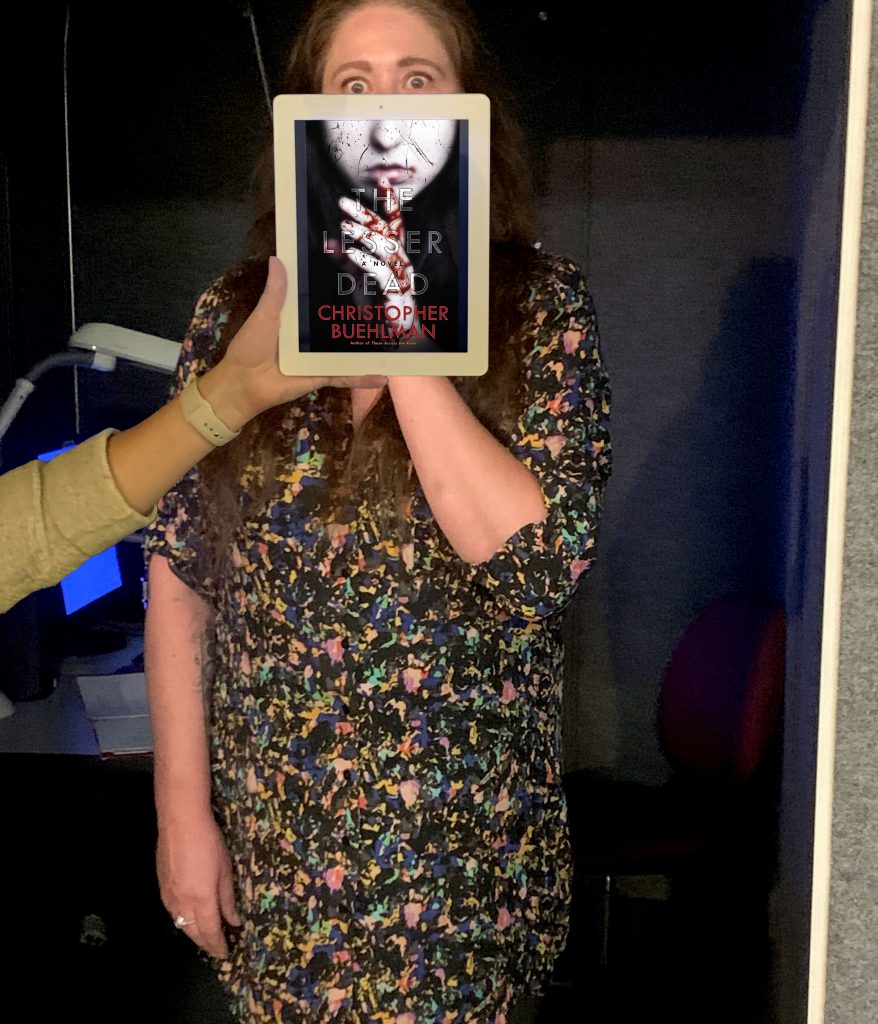
If your go-to Halloween activity is watching a horror flick or visiting a haunted house, you probably also love a scary story. This week’s #BookFaceFriday is the perfect way to get your adrenaline flowing; check out “The Lesser Dead” by Christopher Buehlman (Berkley, 2014.) This title is available as an eBook in Nebraska OverDrive Libraries. Find this title and other tales of horror in Nebraska OverDrive’s curated collection, “Hallow-Reads: Spooky tales for October nights“!
“Cormac McCarthy’s The Road meets Chaucer’s Canterbury Tales in this frightful medieval epic…Buehlman…doesn’t scrimp on earthy horror and lyrical writing in the face of unspeakable horrors…an author to watch.”
—Kirkus Reviews
Libraries participating in the Nebraska OverDrive Libraries Group currently have access to a shared and growing collection of digital downloadable audiobooks and eBooks. 189 libraries across the state share the Nebraska OverDrive collection of 21,696 audiobooks, 35,200 eBooks, and 3,964 magazines. As an added bonus it includes 130 podcasts that are always available with simultaneous use (SU), as well as SU ebooks and audiobook titles that publishers have made available for a limited time. If you’re a part of it, let your users know about this great title, and if you’re not a member yet, find more information about participating in Nebraska Overdrive Libraries!
Love this #BookFace & reading? Check out our past #BookFaceFriday photos on the Nebraska Library Commission’s Facebook page!
Posted in Books & Reading
Tagged Book Covers, bookface, bookfacefriday, books, Christopher Buehlman, Ebook, Horror, Nebraska OverDrive Libraries, OverDrive, Reading, The Lesser Dead
1 Comment
Friday Reads: The Brothers Hawthorne, by Jennifer Lynn Barnes
After Holli Duggan wrote a Friday Reads post about it, I listened to the Inheritance Games trilogy last year–and loved it! So when a fourth book in this YA series was released this summer, I had to listen to that as well, and it did not disappoint. A 5th book, The Grandest Game, is due out in July 2024.
Four brothers. Two missions. One explosive read. And the stakes have never been higher.
Grayson Hawthorne was raised as the heir apparent to his billionaire grandfather, taught from the cradle to put family first. Now the great Tobias Hawthorne is dead and his family disinherited, but some lessons linger. When Grayson’s half-sisters find themselves in trouble, he swoops in to do what he does best: take care of the problem—efficiently, effectively, mercilessly. And without getting bogged down in emotional entanglements.
Jameson Hawthorne is a risk-taker, a sensation-seeker, a player of games. When his mysterious father appears and asks for a favor, Jameson can’t resist the challenge. Now he must infiltrate London’s most exclusive underground gambling club, which caters to the rich, the powerful, and the aristocratic, and win an impossible game of greatest stakes. Luckily, Jameson Hawthorne lives for impossible.
Drawn into twisted games on opposite sides of the globe, Grayson and Jameson—with the help of their brothers and the girl who inherited their grandfather’s fortune—must dig deep to decide who they want to be and what each of them will sacrifice to win.
** Synopsis courtesy of Audible.
Posted in Books & Reading, General, Information Resources
Tagged Book Covers, books, Friday Reads, Reading
Leave a comment
Friday Reads: Nasty, Brutish, and Short: Adventures in Philosophy with My Kids, by Scott Hershovitz
A Facebook friend who also happens to be a librarian recently posted “If you want to have a cursory understanding of a complex topic…get a children’s book about it.” Brilliant counsel! And while that’s not exactly what I did, it was in the back of my mind when I stumbled on Nasty, Brutish, and Short: Adventures in Philosophy with My Kids, by Scott Hershovitz.
Nasty, Brutish, and Short isn’t a children’s book, but it is a book by a philosopher recounting conversations he’s had with his young sons, Rex and Hank, about philosophy. I figured if he could make philosophy accessible to them, maybe he could do the same for me. That, it turns out, was his plan all along. As he writes in the introduction, “[t]his book is inspired by kids, but it’s not for them. In fact, kids are my Trojan horse. I’m not after young minds. I’m after yours.”
In twelve chapters, each devoted to a topic ripe for discussion (rights, punishment, authority, knowledge, truth, etc.), Hershovitz shares stories of children (his own and others’) initiating and participating in philosophical inquiry with greater facility than most adults. In fact, as he goes on to show, they often wind up pondering the exact same questions as renowned philosophers of yore! (Examples include the shifted color spectrum, credited to John Locke, Aquinas’ first cause argument, and Descartes’ Cogito: “I think, therefore I am.”)
Chapter Four of Nasty, Brutish, and Short, titled “Authority,” is a good example of how Hershovitz approaches his subject. He begins with a kid-related anecdote—his son Rex refusing to comply with his father’s request that he put on his shoes. Kids’ chafing at parental authority is nothing new. What kid hasn’t uttered the phrase “You aren’t the boss of me!” to a frazzled parent seeking compliance? And what parent hasn’t responded “Because I said so” when asked “Why” by a stubborn child?
For Hershovitz, however, such encounters are great jumping off points for discussions about power vs. authority, the nature of obligation, and the role reasoning and responsibility should play in compliance. He writes about these concepts as they play out in contemporary life–between bosses and employees, parents and children, teachers and students, the government and the governed. (Gordon Ramsay in Kitchen Nightmares even makes a cameo.) He shares various philosophers’ takes on authority, as well as highlights from his many conversations with Rex and Hank about the subject.
By the end of each chapter you realize not only that Hershovitz has gotten you to “do philosophy” with him, but also that philosophy—thinking carefully about important things–is something worth practicing ourselves and encouraging in our children. (Don’t worry—Hershovitz is well aware that there is a time and a place, especially with kids!)
In his conclusion, titled “How to Raise a Philosopher,” Hershovitz reminds us of what he thinks the goal should be:
The aim is not to raise a professional philosopher. It’s to raise a person who thinks clearly and carefully. It’s to raise a person who thinks for themself. It’s to raise a person who cares what others think—and thinks with them. In short, the aim is to raise a person who thinks.
Definitely a worthy goal! And an inspiring read!
Hershovitz, Scott. Nasty, Brutish, and Short: Adventures in Philosophy with My Kids. New York: Penguin, 2022.
#BookFaceFriday “Daughter of Fortune” by Isabel Allende
Fortune favors the #BookFaceFriday!
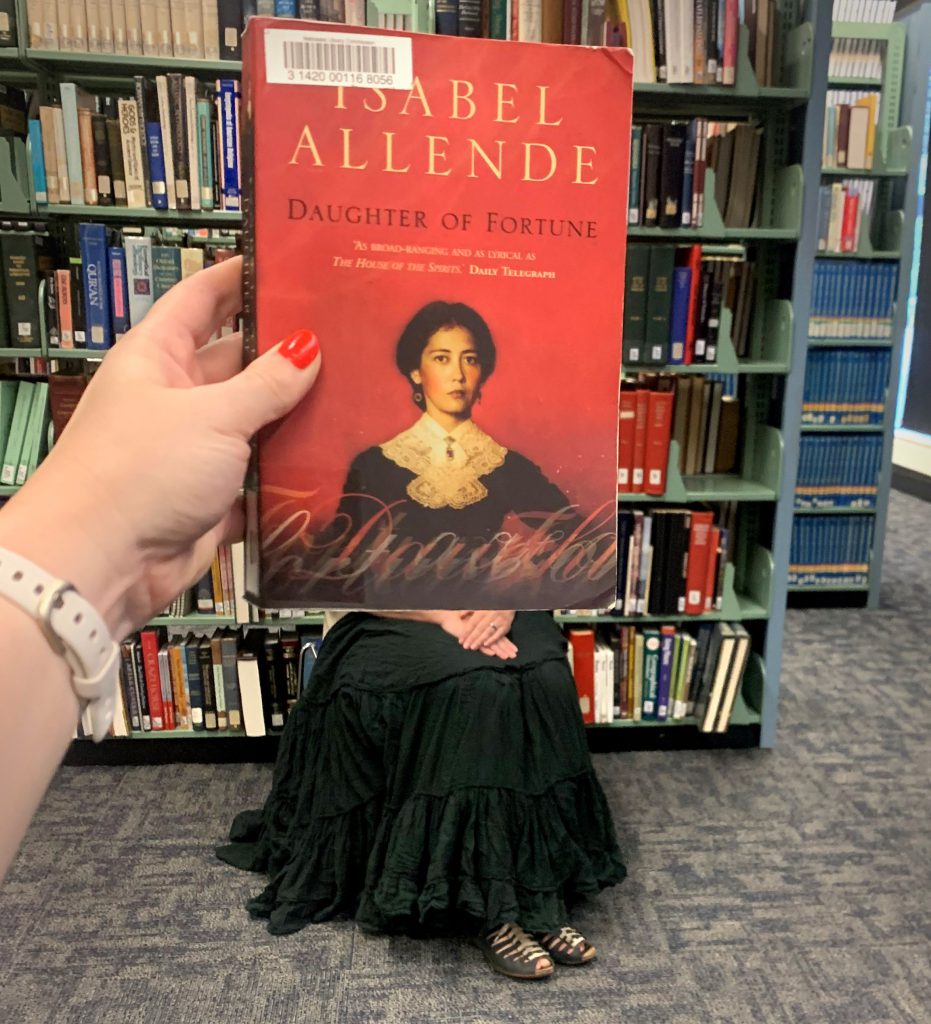
This #BookFaceFriday is written by one of the many talented authors we are celebrating during National Hispanic American Heritage Month (September 15- October 15), Isabel Allende. Set against the backdrop of the 1849 gold rush in California, Daughter of Fortune (Harper Collins, 1999) is available as a Book Club Kit, as well as an audiobook in Nebraska Overdrive Libraries. You can find many more of Allende’s works as ebooks and audiobooks in Nebraska Overdrive Libraries, as well as all of our curated Hispanic Heritage Month collection titles.
“Until Isabel Allende burst onto the scene with her 1985 debut, The House of the Spirits, Latin American fiction was, for the most part, a boys’ club comprising such heavy hitters as Gabriel García Márquez, Jorge Luis Borges, and Mario Vargas Llosa. But the Chilean Allende shouldered her way in with her magical realist multi-generational tale of the Trueba family, followed it up with four more novels and a spate of nonfiction, and has remained in a place of honor ever since. Her sixth work of fiction, Daughter of Fortune, shares some characteristics with her earlier works: the canvas is wide, the characters are multi-generational and multi-ethnic, and the protagonist is an unconventional woman who overcomes enormous obstacles to make her way in the world. Yet one cannot accuse Allende of telling the same story twice; set in the mid-1800s, this novel follows the fortunes of Eliza Sommers, Chilean by birth but adopted by a British spinster, Rose Sommers, and her bachelor brother, Jeremy, after she is abandoned on their doorstep.”
– Margaret Prio, Oprah Book Club
Book Club Kits Rules for Use
- These kits can be checked out by the librarians of Nebraska libraries and media centers.
- Circulation times are flexible and will be based upon availability. There is no standard check-out time for book club kits.
- Please search the collection to select items you wish to borrow and use the REQUEST THIS KIT icon to borrow items.
- Contact the Information Desk at the Library Commission if you have any questions: by phone: 800/307-2665, or by email: Information Services Team
Love this #BookFace & reading? Check out our past #BookFaceFriday photos on the Nebraska Library Commission’s Facebook page!
Book Club Spotlight – How the Garcia Girls Lost Their Accents

In 1960, ten-year-old Julia Alvarez left her home in the Dominican Republic for the United States, and by 2013, she was awarded the National Medal of Arts by President Obama and had an honorary doctorate from Pontificia Universidad Católica Madre y Maestra. So, to end Hispanic Heritage Month, we’re Spotlighting Alvarez’s debut book, which has been widely studied and lauded as a hallmark in Latino Literature. How the Garcia Girls Lost Their Accents is an episodic novel that encapsulates the Dominican immigrant identity in the United States and their struggles of assimilation, heritage, and identity.
When Carla, Sandra, Yolanda, and Sofía were children, their family was forced to flee the Dominican Republic to escape the dictatorship of Rafael Leónidas Trujillo. But that was 30 years ago, and now the sisters who are “too American” for their parents find themselves lost in an identity they never had the chance to form. As the narrative progresses (or regresses), short vignettes of each sister encapsulating their lives move backward in time toward their beginnings in the Dominican Republic. They struggle to cope with the distinct differences in women’s liberation and expectations between their two homes. In the United States, they are expected by their peers to be free-spirited, educated, and beautiful. At the same time, their visits back home are shadowed by the traditional values of Catholicism, a patriarchal society, and their own set of beauty standards. Torn between being acceptable in each culture but still their own people, each member of the family faces immense pressure and collapse. Their mother dreams of becoming an inventor, and their father struggles with sudden poverty; Sandra becomes weighed down by the impossibilities of beauty and stress, while Yolanda, a struggling writer, is caught between her cultures of liberation, joy, and failure. Even 30 years after immigrating, each of the four sisters tries their best to live up to unreachable standards and criticism but never quite feels whole, as if some part of themselves was left back in the Dominican Republic, where they were pushed too soon from their nest.
They will be haunted by what they do and don’t remember.
Julia Alvarez
Told using a reverse timeline, How the Garcia Girls Lost Their Accents keeps the reader in a sense of hesitation and disarray as we are pulled further back into the sisters’ own discordant existence between cultures. Their story is complex and reflects the natural uncertainties and confusion of being out of one’s space and into a new and unknown environment. Perfect for reading groups of mature Young Adult readers and above, How the Garcia Girls Lost Their Accents opens itself up to deep and possibly intense discussions of the self. The stories explore the Female experience as much as it explores the Immigrant one, as a perfect study of Intersectionality (a type of analysis coined by feminist scholar and American Civil Rights leader Kimberlé Williams Crenshaw). Exploring how every aspect of our identities is shaped by the other, or as Alvarez puts it in her Authors Note: “There is nothing shameful in being a complex human being.”
Last week (October 1-7) was Banned Books Week– and Julia Alvarez is no stranger to censorship. How the García Girls Lost Their Accents has had its fair share of challenges and bans- even being banned from the whole of Johnston County, NC, including classrooms and school libraries. During that time, Alvarez spoke with the National Coalition Against Censorship about her experience.
Here is a small excerpt:
NCAC: How does removing a book from a school district affect students’ educational experience?
Julia Alvarez: The sad thing about the controversy, over and above the fact that students have missed out on the reading experience of that book, is what this models for them about an experience that is difficult or upsetting. I grew up in a dictatorship, where you couldn’t talk about difficult situations – there was this culture of silence. We would run into a problem and have no one to talk to. What’s modeled there by banning the book is what I find most upsetting: that it is appropriate behavior in a free country when someone is expressing something we don’t want to hear, to silence them.
NCAC: Why do you think it is important to teach literature that some might deem controversial or difficult?
Julia Alvarez: Schools provide safe spaces to talk about controversial issues, and literature presents characters portraying human experience in all its richness and contradictoriness. Reading is a way to take in the difficult situations and understand them. The whole point of reading a book in class is to have discussion about what these situations are like. You have writing, discussion, and classroom exercises on it, and kids come out of it having digested the experience with ways to feel and talk about it. How wonderful!
If you’re interested in requesting How the Garcia Girls Lost Their Accents for your book club, you can find the Request Form here. There are 10 copies available. (A librarian must request items)
Alvarez, Julia. How the Garcia Girls Lost Their Accents. Algonquin Books. 1991
Posted in Books & Reading
Tagged book club spotlight, books, Hispanic heritage month, Reading
2 Comments
NCompass Live: Letters About Literature 2023
Learn about Nebraska’s state reading and writing contest for youth, Letters About Literature, on next week’s NCompass Live webinar on Wednesday, October 11, at 10am CT.
The Nebraska Center for the Book is a statewide organization dedicated to the promotion of reading in all its forms. Its annual Nebraska Letters About Literature contest allows students in 4th through 12th grade to write to authors (living or deceased) about their favorite book or poem about how his or her book affected their lives. This session will provide helpful information for teachers and librarians interested in the competition. It will also cover the submission process and be an excellent opportunity to ask questions about the entire competition process. Teachers will be interested in this program that will help enhance and extend their classroom instruction.
Presenter: Tessa Terry – Communications Coordinator, Nebraska Library Commission.
Upcoming NCompass Live shows:
- Oct 18 – Learning Opportunities and Resources from WebJunction
- Oct 25 – Pretty Sweet Tech: How Augmented Reality Can Create Optimal Literacy Experiences
- Nov. 8 – Racial & Gender Bias in Search
- Nov. 22 – Best New Children’s Books of 2023
- Dec. 6 – Using Creativity to Grow & Develop
- Dec. 20 – Summer Reading Program 2024: Adventure Begins at Your Library
- Jan. 17, 2024 – Auditing Library Websites
- Jan. 24, 2024 – Best New Teen Reads of 2023

To register for an NCompass Live show, or to listen to recordings of past shows, go to the NCompass Live webpage.
NCompass Live is broadcast live every Wednesday from 10am – 11am Central Time. Convert to your time zone on the Official U.S. Time website.
The show is presented online using the GoTo Webinar online meeting service. Before you attend a session, please see the NLC Online Sessions webpage for detailed information about GoTo Webinar, including system requirements, firewall permissions, and equipment requirements for computer speakers and microphones.
